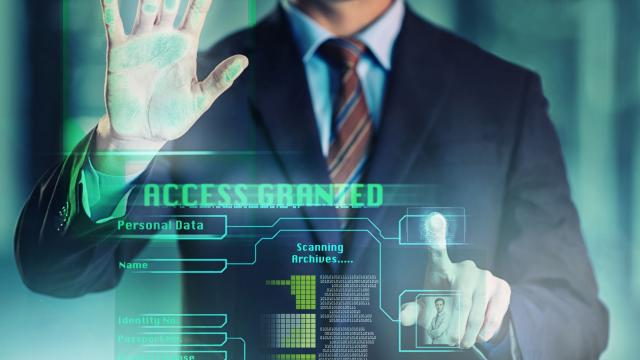Biometric Systems for Identification, Authentication and Verification.
Biometric devices are a tried and tested method for accurate user identification. But, a biometric device attached to a swing door will not mitigate the risk of tailgating into the most secure areas of a building. Biometric devices must be paired with physical security entrances to address unauthorized entry effectively. When placed in the interior of our most sophisticated entry system - the security portal - biometric devices ensure that not only one person gets through at a time, but the right person.
What is Biometric Authentication?
Conventional access methods have their weaknesses. Cards can be stolen, and pins or keys can be forgotten. Biometric devices require distinguished biological traits (iris patterns, fingerprints, facial geometry) to gain access to the secure area of a building. These traits cannot easily be recreated and will never be forgotten by the user. Biometric devices also allow businesses to implement two or multi-factor authentication techniques to decrease further the possibility of an intruder infiltrating the building.
Types of Biometric Authentication Systems
- Eyes – iris scanners
- Eyes – retina scanners
- Fingerprint readers
- Hand geometry readers
- Facial recognition scanners
- Vein recognition scanners
How do Biometric Authentication Systems Work?
Integration between biometric devices and security entrances can be a fine art: the perfect balance between functionality, space and aesthetics. While all security entrances have a designated place for mounting a biometric device, based primarily on space, these places may not fit your exact and individual needs. Some alternative integration options include custom pedestals, top-mounted and interior-mounted.
Once the location has been determined, biometric devices can connect to the entrance and access control systems. Effective at confirming the identity of a user, biometrics are the future for authentication devices.
Advanced Security by Pairing Biometric Authentication Systems and Security Entrances
Vice President of Technology and Product Support, Kurt Measom, walks you through just a few options of combining biometric authentication systems and security entrances for optimal security.
Entry Assurance with High Security Portals
A biometric device provides the biggest benefit when it is integrated with a security portal. This unique security entrance has been trusted to protect data centers and other sensitive locations across the globe. Here is how a high security portal works with biometrics:
- A user presents a credential outside the portal. This could be an access card or biological trait.
- Once inside the portal an overhead sensor system verifies that the person inside is alone.
- After the first door closes, an internal biometric device verifies that the person who presented their credential outside the portal is the same person inside the portal now.
- Once confirmation is granted, the second set of doors open to allow the user into the secure area.
Why is this method of dual authentication so effective? Imagine this scenario. An employee’s husband decides to drive to your facility. He is determined to confront one of his wife’s colleagues. With his wife’s access badge in hand, he steps up to the portal, presents her credentials, and enters the door. The portal verifies that he is alone. An interior biometric device is the difference between this unauthorized person getting to his wife’s colleague, and not. How does it work?
The biometric device is capable of detecting two things in this scenario: (1) the husband is not enrolled in the biometric system and (2) even if he was enrolled, his biometrics do not match the on-file biometrics of the badge owner.
In short, it is much harder for the husband to steal his wife’s eyes, fingerprint, face, etc. to gain access to the building.
Biometric Entrance Solutions
Biometric identifiers are all the measurable characteristics that can be used to describe human beings. Biometrics are increasingly popular in access control applications and Boon Edam products are designed to integrate with most third-party biometric technology. Some of the more popular biometric authentication systems integrated with our security access products include:
Facial Recognition Integration
This method of biometrics uses an algorithm to filter a human face from a video or photograph. Within milliseconds, the face's characteristics are recorded and converted into a unique code. After this code matching process, facial recognition software compares the code to a database. If it finds a match, this can be used to identify the individual in the image and determine whether or not to allow access.
Iris Scanning Integration
Every human iris has its own unique traits. An iris scanner identifies pits, furrows and striations in the iris and converts these into an iris code. Comparing this code to a database subsequently determines whether to allow access. There are many advantages to this technology from being touchless and hygienic to a low false rejection rate.
Fingerprint Reader Integration
This technology works by registering the unique pattern of lines on the skin. The resulting data can be used to determine whether to allow access. Some advanced systems use four fingers in 3D for maximum accuracy - with only one pass of the hand over the sensor. This ergonomic touchless solution delivers an unmatched combination of security, convenience and throughput.
Dexus Gateway Building
Location: Sydney, Australia - Product: Lifeline Speedlane Swing, Lifeline Boost (MorphoWave Compact option)
Dexus Wholesale Property Fund has upgraded the Gateway Building in Sydney’s Circular Quay to feature entry security measures to protect employees, visitors and valuable data. The ideal solution was found by integrating Boon Edam Speedlane Swing optical turnstiles, IDEMIA’s MorphoWave touchless fingerprint scanners, Schindler’s elevator dispatch and Honeywell’s access control technology.

